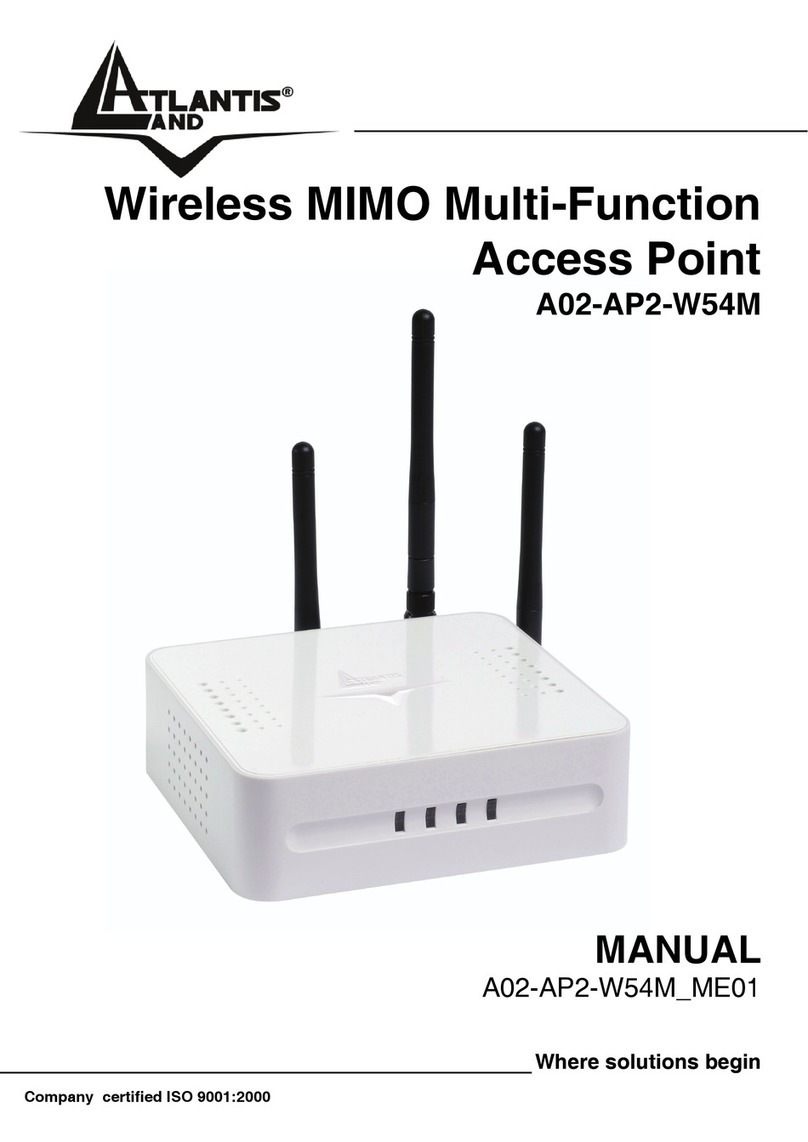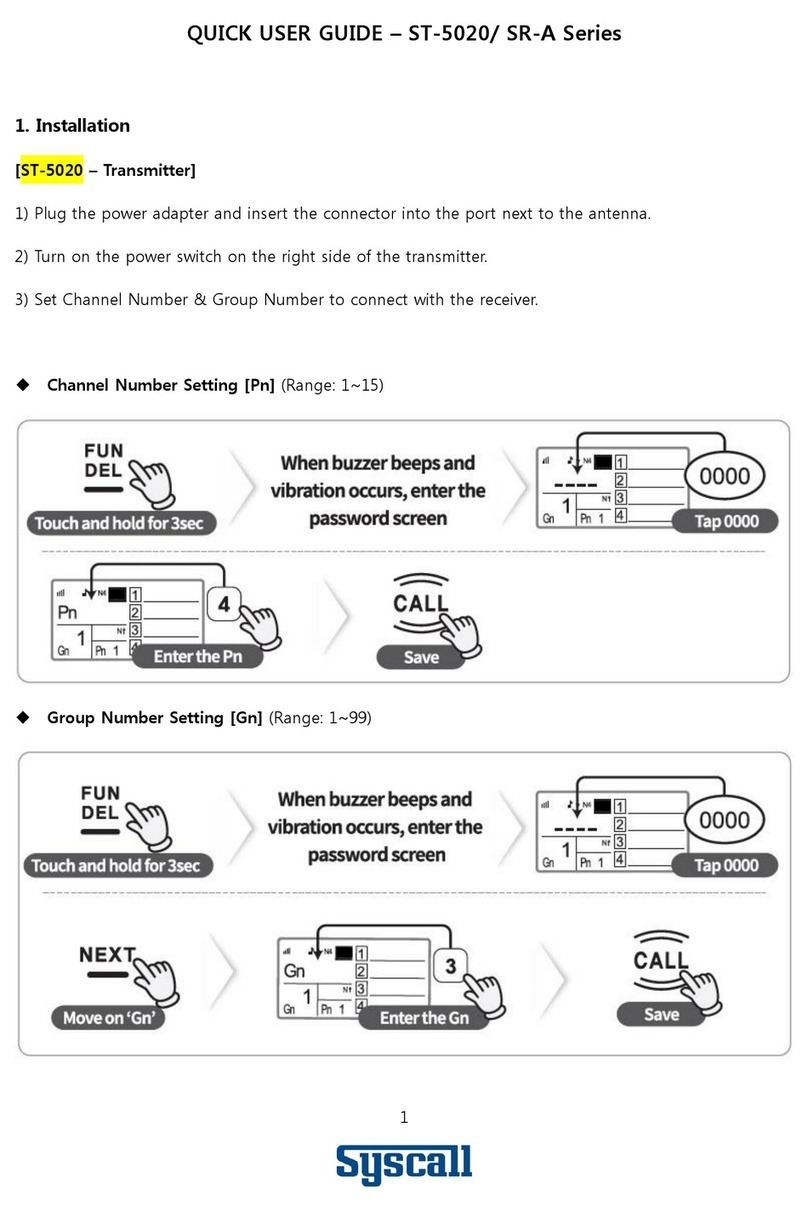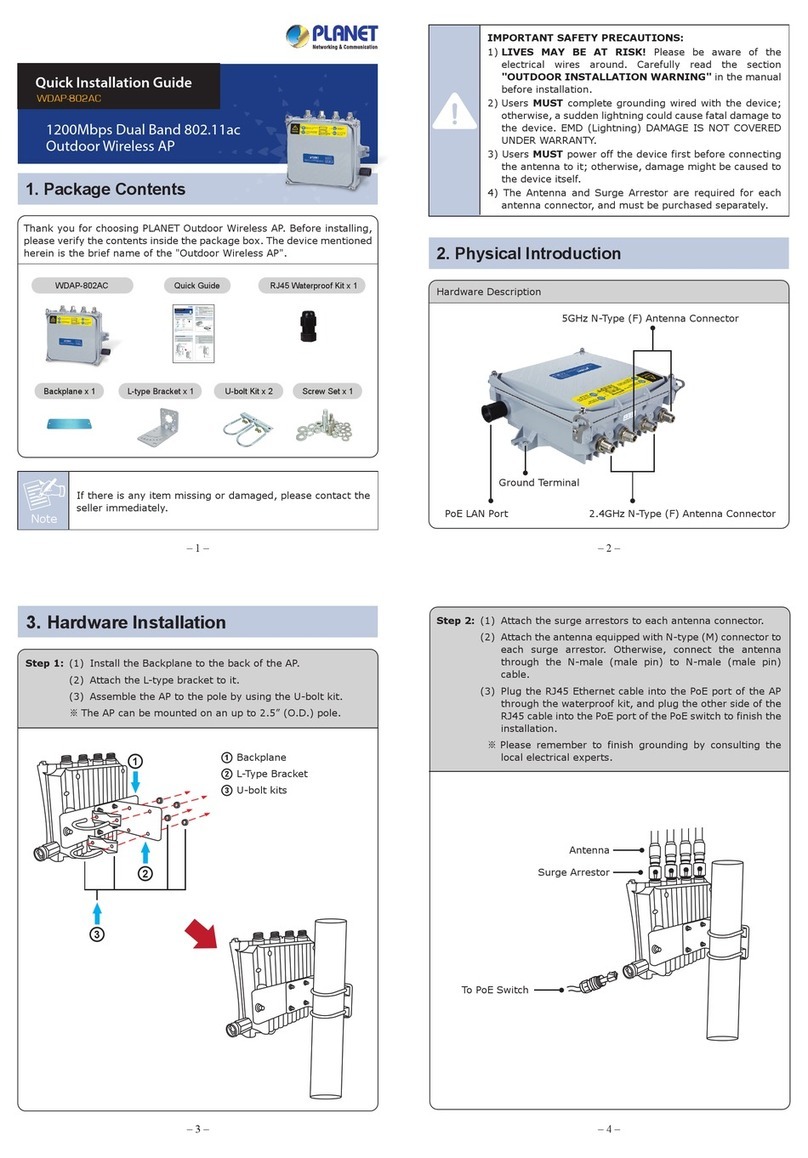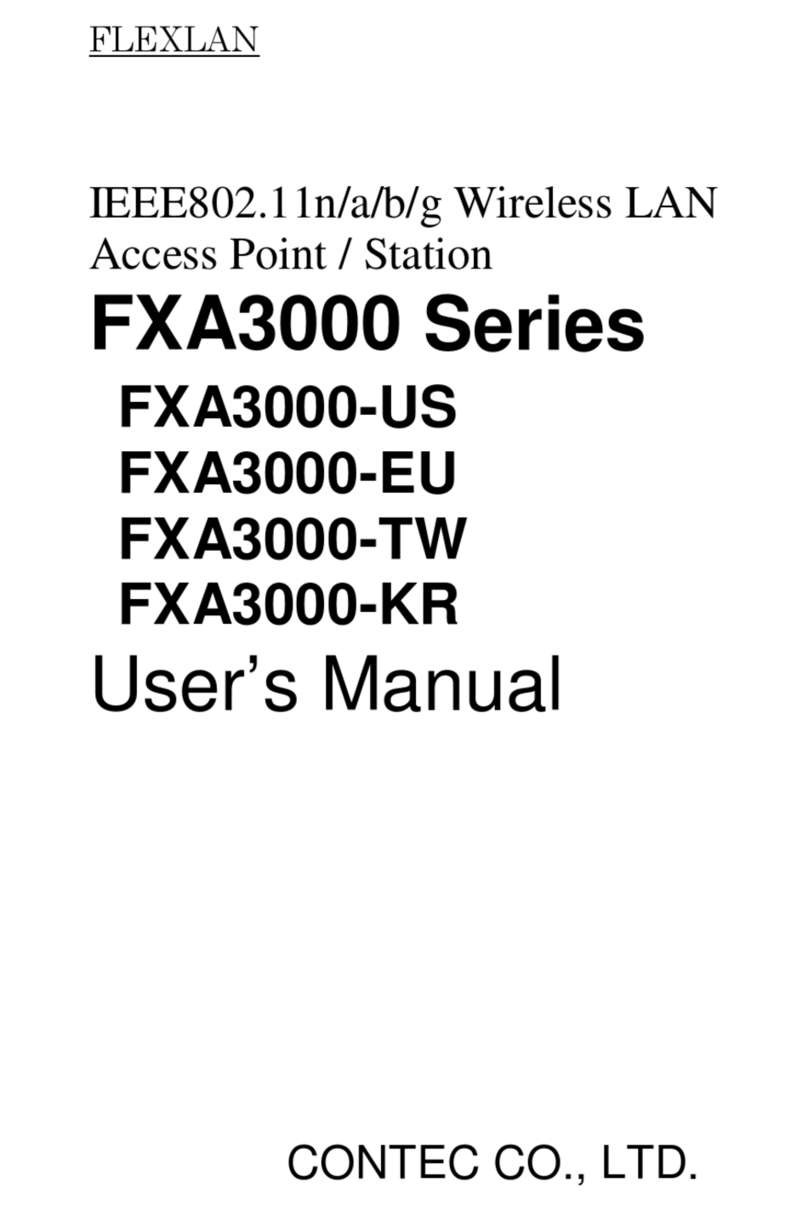MEN Mikro Elektronik NM50 User manual

User Manual
2016-05-1720NM50-00 E2
NM50
Mobile Gateway & WLAN Access Point
Industrial Stand-Alone Device

20NM50-00 E2 2016-05-17 Page 2
NM50 Mobile Gateway & WLAN Access Point
NM50 Mobile Gateway & WLAN Access Point
Maintenance Free and Extremely Rugged
The NM50 is a fanless and maintenance-free wireless access point, specifically designed
for use in railway cars and automotive applications operating in rugged environmental
conditions.
High Speed Internet and OpenWrt Firmware
The NM50 Access Point can support up to two WLAN modules, and provides reliable high
speed internet and local data connection to multiple WLAN compatible devices. A
configurable firewall protects WLAN clients and supports secure and uninterrupted
internet data access. The full-featured and modifiable firmware OpenWrt, allows easy
configuration of features.
High Performance Processor
The NM50 Access Point is based on QorIQ Power PC CPU technology from NXP. The
system is designed for fanless operation in temperatures ranging from -40 to +70°C
(+85°C for up to 10 minutes). Its special aluminum housing with cooling fins serves as a
heatsink for the internal electronics, and in this way provides conduction cooling. As a
member of the MEN family of extremely rugged industrial box PCs, the NM50 provides
the same flexibility and scalability, as well as a look and feel which is common to the
family.
Extended Coverage and Service Availability
A redundant upstream connection to a local server, or downstream to other access
points, to extend coverage and increase availability of service, is achieved via the two
Gigabit Ethernet ports available on 8-pin M12 connectors.
Compliant to Railway and Automotive Standards
The voltage supply for the fully configured NM50 Access Point is designed for maximum
flexibility and supports wide range input supply voltages from 14.4 to 154 VDC, and
meets all EN 50155 requirements for voltages ranging from 24 to 110 VDC. It is also fully
compliant to ISO 7637-2 (E-mark for automotive) standard.
Adaptable to Specific Application Needs
The NM50 comes in two standard versions and can be adapted to meet specification
application needs. Some of the most important configuration options include the
number of WLAN radios and type of upstream link.

20NM50-00 E2 2016-05-17 Page 3
Diagram
Diagram
®
USB2.0SeriesAInterface
DiscreteI/O
USB2.0SeriesBInterface
Status/ActivityLEDs
AntennaRP‐TNCConnectors
EarthingStud
PowerSupplyConnector
GigabitEthernetM12A‐CodedConnectors
AntennaRP‐TNCConnectors
MountingHoles
Frontpanelismodeldependent.

20NM50-00 E2 2016-05-17 Page 4
Technical Data
Technical Data
Supported Port Types
The following configurations are available:
-Entry: 1x 10/100/1000BASE-T M12 connector, wide range power input,
1x WLAN Radio, 2x RP-TNC antenna connectors (Model: 09NM50-00)
-High End: 2x 10/100/1000BASE-T M12 connectors, wide range power input,
2x WLAN radio, 4x RP-TNC antenna connectors, 1x USB 2.0 series A,
1x USB 2.0 series B, 2x discrete I/O) (Model: 09NM50-01)
CPU
NXP QorIQ P1013
-One high-performance Power Architecture e500v2 core
-800 MHz processor core frequency
Memory
32 KB L1 instruction cache
32 KB L1 data cache
256 KB L2 cache/SRAM
1 GB DDR3 SDRAM system memory
-Soldered
32 MB NOR Flash
Mass Storage
Via USB 2.0 host port at the front (Model: 09NM50-01)
Protocols and Functionality
Management I/F
-Integrated FW WEB/browser based setup and maintenance
-Local interface
-Firmware update from USB and Ethernet
Firewall
-Full featured firewall
-SSID show/hide
-MAC/IP/port filtering
-Multiple zone
Please contact MEN sales for configuration possibilities.

20NM50-00 E2 2016-05-17 Page 5
Technical Data
Security
-WEP 64 and 128 bit
-WPA/WPA2 Personal and Enterprise
General Protocols
-Proxy ARP, DNS, HTTP, HTTPS, IP, ICMP, SNTP, TCP, UDP, RADIUS, SNMP, PPPoE,
DHCP
AP Protocols
-A R P, B O OT P, D H C P, S T P / R S T P ( I E E E 8 0 2 . 1 D / w )
Routing
-Optional feature when Cellular upstream option is selected
-Static and dynamic routing, IPv46 IPv6, TCP/IP, UDP, ICMP, STP, RSTP, MSTP, RIPv1,
RIPv2, RIPng
Remote monitoring and maintenance via Ethernet and WLAN
Local monitoring and maintenance via USB device port (Model: 09NM50-01)
Software initiated restart
Watchdog
Connectivity
USB host at front for mass storage (Model: 09NM50-01)
USB device for maintenance (Model: 09NM50-01)
WiFi Network
-Up to two WiFi 802.11b/g/n/ac modems (UC-Option)
-2x2 MIMO supported
-Optional antenna diversity for each radio
-Maximum data rate 300 Mbit/s (n); 54 Mbit/s (g), 11 Mbit/s (b)
-Both 2.4GHz and 5GHz supported (depending on configuration)
-Unlimited parallel users; Bandwidth-limited to 60 per WiFi RF interface
Cellular Network (Available on request only)
-3.5G/4G modem (UC-Option)
Discrete I/O (Model: 09NM50-01)
Opto-isolated output (open collector) user programmable status output
-Reports device status to external devices
-Freely programmable via Web browers or console I/F
-Report sevice error signal/flag to host option
Opto-isolated output user programmable input
-Freely programmable via Web browers or console I/F
-Report external device status to Access Point option
-Report 'engine off' in bus applicaion option
One dedicated W_Disable input
-Active low signal to disable RF operation
-Direct disable of radio operation on either WLAN or cellular cards
Discrete input levels
-Input current for high:
-Input current for low: <1 mA
-Input switching level: 40 to ±5%
Independent input reference voltage range 0 to 154 V
Optocoupler shutter control option
Only available on the NM50 version with full configuration

20NM50-00 E2 2016-05-17 Page 6
Technical Data
Front Interfaces
One USB 2.0 series A, host port (Model: 09NM50-01)
-Series A connector at front panel
-Firmware and configuration update support
One USB 2.0 series B, device port (Model: 09NM50-01)
-Series B connector at front panel
-Console-mode maintenance support
Ethernet 1
-10/100/1000Base-T Ethernet channels
-M12 8-pin A-coded connector
-Two LEDs to signal LAN link and activity status
Ethernet 2 (Model: 09NM50-01)
-10/100/1000Base-T Ethernet channels
-M12 8-pin A-coded connector
-Two LEDs to signal LAN link and activity status
Antenna
-Two Type RP-TNC antenna connectors (Model: 09NM50-00)
-Four Type RP-TNC antenna connectors (Model: 09NM50-01)
Discrete I/O (Model: 09NM50-01)
-6-pin double row connector, 3.5 mm
LEDs
-Power status
-Fault LED: Indicates error codes from the board controller
-Ethernet link and activity status
-User LEDs for WLAN activity
Power Input
-RM3.5 3-pol plug-in connector
In-System Interfaces
One PCI Express Mini Card slot (09NM50-00)
Two PCI Express Mini Card slots (09NM50-01)
One SIM card slot on PCI Express Mini Card slot 2
Electrical Specifications
Primary power supply
-14.4 to 154 VDC, nominal voltages 24, 36, 48, 72, 96 and 110 VDC according to
EN50155
Power consumption: Less than 15 W
Power interruption class S2 (10 ms)
Mechanical Specifications
Dimensions: Height 44 mm x Width 125 mm x Length 220 mm
Weight: approx. 1.5 kg (depending on configuration)
Mounting
-Wall mount or top mount

20NM50-00 E2 2016-05-17 Page 7
Technical Data
Environmental Specifications
Temperature range (operation):
--40 to 70°C, with up to 85°C for 10 minutes according to class Tx (EN 50155)
-Natural convection, fanless operation
Temperature range (storage): -40 to +85°C
Relative humidity (operation): max. 95% non-condensing
Relative humidity (storage): max. 95% non-condensing
Altitude: -300 m to +3000 m
Shock: 50 m/s², 30 ms (EN 61373)
Vibration (function): 1 m/s², 5 Hz – 150 Hz (EN 61373)
Vibration (lifetime): 7.9 m/s², 5 Hz – 150 Hz (EN 61373)
Conformal coating of internal components
MTBF
70 000 h
Safety
Flammability
-UL 94V-0
Fire Protection
-EN 45545-2
Electrical Safety
-EN 60950-1, class I equipment
EMC Conformity (Automotive)
ISO7637-2 (E-mark)
Software Support
OpenWrt Firmware
See the MEN website for ordering information.

20NM50-00 E2 2016-05-17 Page 8
Product Safety
Product Safety
Electrostatic Discharge (ESD)
Computer boards and components contain electrostatic sensitive devices.
Electrostatic discharge (ESD) can damage components. To protect the
board and other components against damage from static electricity, you
should follow some precautions whenever you work on your computer.
Power down and unplug your computer system when working on the
inside.
Hold components by the edges and try not to touch the IC chips, leads,
or circuitry.
Use a grounded wrist strap before handling computer components.
Place components on a grounded antistatic pad or on the bag that came
with the component whenever the components are separated from the
system.
Only store the board in its original ESD-protected packaging. Retain the
original packaging in case you need to return the board to MEN for
repair.

20NM50-00 E2 2016-05-17 Page 9
About this Document
About this Document
This user manual is intended only for system developers and integrators, it is not
intended for end users.
It describes the design, functions and connection of the product. The manual does not
include detailed information on individual components (data sheets etc.).
History
Issue Comments Date
E1 First issue 2016-04-18
E2 Updated system map, pinning information and
grounding conductor information.
2016-05-17

20NM50-00 E2 2016-05-17 Page 10
About this Document
Conventions
Indicates important information or warnings concerning situations which
could result in personal injury, or damage or destruction of the
component.
Indicates important information or warnings concerning the use of
voltages that could lead to a hazardous situation which could result in
personal injury, or damage or destruction of the component.
Indicates important information concerning electrostatic discharge which
could result in damage or destruction of the component.
Indicates important information or warnings concerning proper
functionality of the product described in this document.
The globe icon indicates a hyperlink that links directly to the Internet.
When no globe icon is present, the hyperlink links to specific information
within this document.
Italics Folder, file and function names are printed in italics.
Mono A monospaced font type is used for hexadecimal numbers, listings, C
function descriptions or wherever appropriate. Hexadecimal numbers are
preceded by "0x".
Comment Comments embedded into coding examples are shown in green text.
IRQ#
/IRQ
Signal names followed by a hashtag "#" or preceded by a forward slash "/"
indicate that this signal is either active low or that it becomes active at a
falling edge.
In/Out Signal directions in signal mnemonics tables generally refer to the
corresponding board or component, "in" meaning "to the board or
component", "out" meaning "from the board or component".

20NM50-00 E2 2016-05-17 Page 11
Legal Information
Legal Information
Changes
MEN Mikro Elektronik GmbH ("MEN") reserves the right to make changes without further
notice to any products herein.
Warranty, Guarantee, Liability
MEN makes no warranty, representation or guarantee of any kind regarding the
suitability of its products for any particular purpose, nor does MEN assume any liability
arising out of the application or use of any product or circuit, and specifically disclaims
any and all liability, including, without limitation, consequential or incidental damages.
TO THE EXTENT APPLICABLE, SPECIFICALLY EXCLUDED ARE ANY IMPLIED WARRANTIES
ARISING BY OPERATION OF LAW, CUSTOM OR USAGE, INCLUDING WITHOUT LIMITATION,
THE IMPLIED WARRANTIES OF MERCHANTABILITY AND FITNESS FOR A PARTICULAR
PURPOSE OR USE. In no event shall MEN be liable for more than the contract price for
the products in question. If buyer does not notify MEN in writing within the foregoing
warranty period, MEN shall have no liability or obligation to buyer hereunder.
The publication is provided on the terms and understanding that:
1. MEN is not responsible for the results of any actions taken on the basis of
information in the publication, nor for any error in or omission from the publication; and
2. MEN is not engaged in rendering technical or other advice or services.
MEN expressly disclaims all and any liability and responsibility to any person, whether a
reader of the publication or not, in respect of anything, and of the consequences of
anything, done or omitted to be done by any such person in reliance, whether wholly or
partially, on the whole or any part of the contents of the publication.
Conditions for Use, Field of Application
The correct function of MEN products in mission-critical and life-critical applications is
limited to the environmental specification given for each product in the technical user
manual. The correct function of MEN products under extended environmental
conditions is limited to the individual requirement specification and subsequent
validation documents for each product for the applicable use case and has to be agreed
upon in writing by MEN and the customer. Should the customer purchase or use MEN
products for any unintended or unauthorized application, the customer shall indemnify
and hold MEN and its officers, employees, subsidiaries, affiliates, and distributors
harmless against all claims, costs, damages, and expenses, and reasonable attorney fees
arising out of, directly or indirectly, any claim or personal injury or death associated with
such unintended or unauthorized use, even if such claim alleges that MEN was negligent
regarding the design or manufacture of the part. In no case is MEN liable for the correct
function of the technical installation where MEN products are a part of.
Qualified Personnel
The product/system described in this documentation may be operated only by
personnel qualified for the specific task in accordance with the relevant documentation,
in particular its warning notices and safety instructions. Qualified personnel are those
who, based on their training and experience, are capable of identifying risks and
avoiding potential hazards when working with these products/systems.

20NM50-00 E2 2016-05-17 Page 12
Legal Information
Conformity
MEN products are no ready-made products for end users. They are tested according to
the standards given in the Technical Data and thus enable you to achieve certification of
the product according to the standards applicable in your field of application.
RoHS
Since July 1, 2006 all MEN standard products comply with RoHS legislation.
Since January 2005 the SMD and manual soldering processes at MEN have already been
completely lead-free. Between June 2004 and June 30, 2006 MEN’s selected component
suppliers have changed delivery to RoHS-compliant parts. During this period any change
and status was traceable through the MEN ERP system and the boards gradually became
RoHS-compliant.
WEEE Application
Nevertheless, MEN is registered as a manufacturer in Germany. The registration number
can be provided on request.
Copyright © 2015 MEN Mikro Elektronik GmbH. All rights reserved.
The WEEE directive does not apply to fixed industrial plants and tools. The
compliance is the responsibility of the company which puts the product on
the market, as defined in the directive; components and sub-assemblies
are not subject to product compliance.
In other words: Since MEN does not deliver ready-made products to end
users, the WEEE directive is not applicable for MEN. Users are
nevertheless recommended to properly recycle all electronic boards which
have passed their life cycle.
Germany
MEN Mikro Elektronik GmbH
Neuwieder Straße 3-7
90411 Nuremberg
Phone +49-911-99 33 5-0
Fax +49-911-99 33 5-901
E-mail [email protected]
www.men.de
France
MEN Mikro Elektronik SAS
18, rue René Cassin
ZA de la Châtelaine
74240 Gaillard
Phone +33 (0) 450-955-312
Fax +33 (0) 450-955-211
E-mail [email protected]
www.men-france.fr
USA
MEN Micro Inc.
860 Penllyn Blue Bell Pike
Blue Bell, PA 19422
Phone (215) 542-9575
Fax (215) 542-9577
E-mail [email protected]
www.menmicro.com

20NM50-00 E2 2016-05-17 Page 13
Contents
Contents
1 Product Description . . . . . . . . . . . . . . . . . . . . . . . . . . . . . . . . . . . . . . . . . . . . 16
1.1 Overview of the System . . . . . . . . . . . . . . . . . . . . . . . . . . . . . . . . . . . . . . . . . . . .16
1.2 External Interfaces . . . . . . . . . . . . . . . . . . . . . . . . . . . . . . . . . . . . . . . . . . . . . . . .17
1.3 Map of the System . . . . . . . . . . . . . . . . . . . . . . . . . . . . . . . . . . . . . . . . . . . . . . . .18
1.4 Block Diagrams . . . . . . . . . . . . . . . . . . . . . . . . . . . . . . . . . . . . . . . . . . . . . . . . . . .19
1.5 Product Identification. . . . . . . . . . . . . . . . . . . . . . . . . . . . . . . . . . . . . . . . . . . . . .20
2 Getting Started . . . . . . . . . . . . . . . . . . . . . . . . . . . . . . . . . . . . . . . . . . . . . . . . 21
2.1 Unpacking the NM50 . . . . . . . . . . . . . . . . . . . . . . . . . . . . . . . . . . . . . . . . . . . . . .21
2.2 Scope of Delivery . . . . . . . . . . . . . . . . . . . . . . . . . . . . . . . . . . . . . . . . . . . . . . . . .21
2.3 Configuring the Hardware . . . . . . . . . . . . . . . . . . . . . . . . . . . . . . . . . . . . . . . . . .22
2.3.1 Handling Internal Components . . . . . . . . . . . . . . . . . . . . . . . . . . . . .22
2.3.2 Opening the NM50. . . . . . . . . . . . . . . . . . . . . . . . . . . . . . . . . . . . . . . .23
2.3.3 Installing PCI Express Mini Cards. . . . . . . . . . . . . . . . . . . . . . . . . . . .24
2.3.4 Inserting a SIM card . . . . . . . . . . . . . . . . . . . . . . . . . . . . . . . . . . . . . . .25
2.4 Installing the NM50. . . . . . . . . . . . . . . . . . . . . . . . . . . . . . . . . . . . . . . . . . . . . . . .26
2.4.1 Wall Mounting. . . . . . . . . . . . . . . . . . . . . . . . . . . . . . . . . . . . . . . . . . . .27
2.5 Connecting the System . . . . . . . . . . . . . . . . . . . . . . . . . . . . . . . . . . . . . . . . . . . .29
2.5.1 Safety Instructions for Connection . . . . . . . . . . . . . . . . . . . . . . . . . .29
2.5.2 Connecting an Earthing Cable . . . . . . . . . . . . . . . . . . . . . . . . . . . . . .29
2.5.3 Connecting Peripherals. . . . . . . . . . . . . . . . . . . . . . . . . . . . . . . . . . . . 30
2.6 Starting the System. . . . . . . . . . . . . . . . . . . . . . . . . . . . . . . . . . . . . . . . . . . . . . . .30
3 Accessing the System . . . . . . . . . . . . . . . . . . . . . . . . . . . . . . . . . . . . . . . . . . . 31
3.1 OpenWrt. . . . . . . . . . . . . . . . . . . . . . . . . . . . . . . . . . . . . . . . . . . . . . . . . . . . . . . . . 31
3.1.1 OpenWrt Configuration. . . . . . . . . . . . . . . . . . . . . . . . . . . . . . . . . . . . 31
3.1.2 Default Configuration . . . . . . . . . . . . . . . . . . . . . . . . . . . . . . . . . . . . .31
3.2 User Interfaces . . . . . . . . . . . . . . . . . . . . . . . . . . . . . . . . . . . . . . . . . . . . . . . . . . .32
3.2.1 LuCI Web Interface. . . . . . . . . . . . . . . . . . . . . . . . . . . . . . . . . . . . . . . .32
3.2.2 U-Boot Interface . . . . . . . . . . . . . . . . . . . . . . . . . . . . . . . . . . . . . . . . . .36
3.3 Configuration and Diagnosis. . . . . . . . . . . . . . . . . . . . . . . . . . . . . . . . . . . . . . . .36
3.3.1 Unified Configuration Interface (UCI) . . . . . . . . . . . . . . . . . . . . . . . .36
3.3.2 Network Configuration . . . . . . . . . . . . . . . . . . . . . . . . . . . . . . . . . . . .38
3.3.3 Package Management . . . . . . . . . . . . . . . . . . . . . . . . . . . . . . . . . . . . .38
3.3.4 U-Boot Environment . . . . . . . . . . . . . . . . . . . . . . . . . . . . . . . . . . . . . .39
3.3.5 NAS Functionality . . . . . . . . . . . . . . . . . . . . . . . . . . . . . . . . . . . . . . . . .40
3.3.6 Network Diagnostic . . . . . . . . . . . . . . . . . . . . . . . . . . . . . . . . . . . . . . .41
3.3.7 Status Information. . . . . . . . . . . . . . . . . . . . . . . . . . . . . . . . . . . . . . . .42
3.4 NM50 Specific Features . . . . . . . . . . . . . . . . . . . . . . . . . . . . . . . . . . . . . . . . . . . .43
3.4.1 Watchdog . . . . . . . . . . . . . . . . . . . . . . . . . . . . . . . . . . . . . . . . . . . . . . . 43
3.4.2 Fault LED . . . . . . . . . . . . . . . . . . . . . . . . . . . . . . . . . . . . . . . . . . . . . . . .43
3.4.3 Discrete I/O . . . . . . . . . . . . . . . . . . . . . . . . . . . . . . . . . . . . . . . . . . . . . .44
3.4.4 Temperature Sensor . . . . . . . . . . . . . . . . . . . . . . . . . . . . . . . . . . . . . .45
3.4.5 EEPROM. . . . . . . . . . . . . . . . . . . . . . . . . . . . . . . . . . . . . . . . . . . . . . . . .45

20NM50-00 E2 2016-05-17 Page 14
Contents
3.5 Firmware Update . . . . . . . . . . . . . . . . . . . . . . . . . . . . . . . . . . . . . . . . . . . . . . . . .45
3.5.1 Firmware Boot . . . . . . . . . . . . . . . . . . . . . . . . . . . . . . . . . . . . . . . . . . .45
3.5.2 Flash Layout . . . . . . . . . . . . . . . . . . . . . . . . . . . . . . . . . . . . . . . . . . . . .46
3.5.3 Update Binary. . . . . . . . . . . . . . . . . . . . . . . . . . . . . . . . . . . . . . . . . . . .46
3.5.4 Flashing Firmware Instructions . . . . . . . . . . . . . . . . . . . . . . . . . . . . .47
4 Functional Description. . . . . . . . . . . . . . . . . . . . . . . . . . . . . . . . . . . . . . . . . . 49
4.1 Power Input . . . . . . . . . . . . . . . . . . . . . . . . . . . . . . . . . . . . . . . . . . . . . . . . . . . . . .49
4.2 Status and Activity LEDs. . . . . . . . . . . . . . . . . . . . . . . . . . . . . . . . . . . . . . . . . . . .50
4.3 USB Interfaces . . . . . . . . . . . . . . . . . . . . . . . . . . . . . . . . . . . . . . . . . . . . . . . . . . . . 50
4.3.1 USB Series A . . . . . . . . . . . . . . . . . . . . . . . . . . . . . . . . . . . . . . . . . . . . .50
4.3.2 USB Series B . . . . . . . . . . . . . . . . . . . . . . . . . . . . . . . . . . . . . . . . . . . . .51
4.4 Ethernet Interfaces . . . . . . . . . . . . . . . . . . . . . . . . . . . . . . . . . . . . . . . . . . . . . . . .51
4.4.1 Ethernet Status LEDs . . . . . . . . . . . . . . . . . . . . . . . . . . . . . . . . . . . . . .52
4.5 Antenna Connectors. . . . . . . . . . . . . . . . . . . . . . . . . . . . . . . . . . . . . . . . . . . . . . .52
4.6 Discrete I/O . . . . . . . . . . . . . . . . . . . . . . . . . . . . . . . . . . . . . . . . . . . . . . . . . . . . . .53
4.6.1 Discrete Input . . . . . . . . . . . . . . . . . . . . . . . . . . . . . . . . . . . . . . . . . . . .53
4.6.2 Discrete Output . . . . . . . . . . . . . . . . . . . . . . . . . . . . . . . . . . . . . . . . . . 54
4.6.3 PCI Express Mini Card Interface . . . . . . . . . . . . . . . . . . . . . . . . . . . . .55
4.6.4 Connection of PCI Express Mini Cards . . . . . . . . . . . . . . . . . . . . . . .55
5 Maintenance . . . . . . . . . . . . . . . . . . . . . . . . . . . . . . . . . . . . . . . . . . . . . . . . . . 57
5.1 Cleaning the System . . . . . . . . . . . . . . . . . . . . . . . . . . . . . . . . . . . . . . . . . . . . . . .57
6 Appendix. . . . . . . . . . . . . . . . . . . . . . . . . . . . . . . . . . . . . . . . . . . . . . . . . . . . . . 58
6.1 Literature and Web Resources . . . . . . . . . . . . . . . . . . . . . . . . . . . . . . . . . . . . . .58
6.1.1 Ethernet. . . . . . . . . . . . . . . . . . . . . . . . . . . . . . . . . . . . . . . . . . . . . . . . .58
6.1.2 Dimensions and mounting template . . . . . . . . . . . . . . . . . . . . . . . .58

20NM50-00 E2 2016-05-17 Page 15
Figures
Figure 1. Entry Level: 09NM50-00 front panel and connectors . . . . . . . . . . . . . . . . . . . .16
Figure 2. High End: 09NM50-01 front panel and connectors. . . . . . . . . . . . . . . . . . . . . .16
Figure 3. Overview of the front panel interfaces and configuration options. . . . . . . . . 17
Figure 4. Basic view of the NM50 interior. . . . . . . . . . . . . . . . . . . . . . . . . . . . . . . . . . . . . .18
Figure 5. Basic block diagram for the NM50 . . . . . . . . . . . . . . . . . . . . . . . . . . . . . . . . . . .19
Figure 6. Product label. . . . . . . . . . . . . . . . . . . . . . . . . . . . . . . . . . . . . . . . . . . . . . . . . . . . . .20
Figure 7. Removing the bottom panel. . . . . . . . . . . . . . . . . . . . . . . . . . . . . . . . . . . . . . . . .23
Figure 8. Removing the back panel . . . . . . . . . . . . . . . . . . . . . . . . . . . . . . . . . . . . . . . . . . .23
Figure 9. Installing a PCI Express Mini Card . . . . . . . . . . . . . . . . . . . . . . . . . . . . . . . . . . . .24
Figure 10. Inserting a SIM card . . . . . . . . . . . . . . . . . . . . . . . . . . . . . . . . . . . . . . . . . . . . . . . .25
Figure 11. Mounting distances required for the network box . . . . . . . . . . . . . . . . . . . . . .26
Figure 12. Mounting the NM50. . . . . . . . . . . . . . . . . . . . . . . . . . . . . . . . . . . . . . . . . . . . . . . .28
Figure 13. NM50 dimension diagram . . . . . . . . . . . . . . . . . . . . . . . . . . . . . . . . . . . . . . . . . .28
Figure 14. Earthing connection (stud) . . . . . . . . . . . . . . . . . . . . . . . . . . . . . . . . . . . . . . . . . . 30
Figure 15. Default configuration. . . . . . . . . . . . . . . . . . . . . . . . . . . . . . . . . . . . . . . . . . . . . . .31
Figure 16. LuCI - status menu . . . . . . . . . . . . . . . . . . . . . . . . . . . . . . . . . . . . . . . . . . . . . . . .32
Figure 17. LuCI - system menu . . . . . . . . . . . . . . . . . . . . . . . . . . . . . . . . . . . . . . . . . . . . . . .33
Figure 18. LuCI - services menu . . . . . . . . . . . . . . . . . . . . . . . . . . . . . . . . . . . . . . . . . . . . . . .34
Figure 19. LuCI - network menu . . . . . . . . . . . . . . . . . . . . . . . . . . . . . . . . . . . . . . . . . . . . . . 34
Figure 20. LuCI - Package management from the web interface. . . . . . . . . . . . . . . . . . . .39
Figure 21. LuCI NAS mount point configuration example . . . . . . . . . . . . . . . . . . . . . . . . .40
Figure 22. LuCI NAS network share configuration . . . . . . . . . . . . . . . . . . . . . . . . . . . . . . .41
Figure 23. LuCI Realtime network connections graph . . . . . . . . . . . . . . . . . . . . . . . . . . . .42
Figure 24. LuCI configuration to blink the fault LED . . . . . . . . . . . . . . . . . . . . . . . . . . . . . .44
Figure 25. Switching behavior. . . . . . . . . . . . . . . . . . . . . . . . . . . . . . . . . . . . . . . . . . . . . . . . .54
Figure 26. Photo couplers (shutters) - 2 lines: . . . . . . . . . . . . . . . . . . . . . . . . . . . . . . . . . . .54
Tables
Table 1. Linux device names for the front panel interfaces . . . . . . . . . . . . . . . . . . . . . . 31
Table 2. Flash partitions . . . . . . . . . . . . . . . . . . . . . . . . . . . . . . . . . . . . . . . . . . . . . . . . . . .46
Table 3. Pin assignment of the power supply connector . . . . . . . . . . . . . . . . . . . . . . . .49
Table 4. Signal description of the power supply connector . . . . . . . . . . . . . . . . . . . . . .49
Table 5. General status LEDs at front panel . . . . . . . . . . . . . . . . . . . . . . . . . . . . . . . . . . .50
Table 6. Pin assignment of USB series A front-panel connectors . . . . . . . . . . . . . . . . .50
Table 7. Signal mnemonics of USB series A front-panel connectors. . . . . . . . . . . . . . .50
Table 8. Pin assignment of USB series B front-panel connectors . . . . . . . . . . . . . . . . . 51
Table 9. Signal mnemonics of USB series B front-panel connectors. . . . . . . . . . . . . . . 51
Table 10. Pin assignment of Ethernet front-panel connector. . . . . . . . . . . . . . . . . . . . . . 51
Table 11. Signal mnemonics of Ethernet front-panel connectors . . . . . . . . . . . . . . . . . . 52
Table 12. Ethernet status LEDs . . . . . . . . . . . . . . . . . . . . . . . . . . . . . . . . . . . . . . . . . . . . . . .52
Table 13. Photo coupler characteristics: . . . . . . . . . . . . . . . . . . . . . . . . . . . . . . . . . . . . . . .54
Table 14. Pin assignment of 52-pin PCI Express Mini Card connector . . . . . . . . . . . . . .55
Table 15. Signal mnemonics of 52-pin PCI Express Mini Card connector. . . . . . . . . . . . 56

Product Description
20NM50-00 E2 2016-05-17 Page 16
1 Product Description
This chapter provides an overview of the system in a typical configuration, and also
highlights the various possible configuration options.
1.1 Overview of the System
Figure 1. Entry Level: 09NM50-00 front panel and connectors
Figure 2. High End: 09NM50-01 front panel and connectors
A
L
P
F
A
L
WLAN1
WLAN2
ETH2
PWR
X4
X1
A
L
P
F
A
L
WLAN1
WLAN2
USB2 USB1 X10
ETH2 ETH1
PWR
X4

Product Description
20NM50-00 E2 2016-05-17 Page 17
1.2 External Interfaces
The following illustrations display the standard front panel and connectors available on
the entry level and high end versions of the network box. All interfaces are located on
the front panel of the NM50.
Figure 3. Overview of the front panel interfaces and configuration options
®®
1 42
76
USB2.0SeriesAInterface1
2
3
4
5
6
7DiscreteI/O
USB2.0SeriesBInterface
Status/ActivityLEDs
AntennaRP‐TNCConnectors
EarthingStud
PowerSupplyConnector
8 6
5
Entry09NM50‐00
3
8GigabitEthernetM12A‐CodedConnectors
HighEnd:09NM50‐01
Status/ActivityLEDs1
2
3
4
5PowerSupplyConnector
EarthingStud
AntennaRP‐TNCConnectors
GigabitEthernetM12A‐CodedConnector
®
2
45
31

Product Description
20NM50-00 E2 2016-05-17 Page 18
1.3 Map of the System
Figure 4. Basic view of the NM50 interior
SIMCardSlotforPCIeMiniCardSlot21
2
3
4
7
8
9USB2.0SeriesAInterface
PCIExpressMiniCardSlot2
PCIExpressMiniCardSlot1USB2.0SeriesBInterface
DiscreteI/O
FuseS1(5AT)
1
568 9
3
7
2
6GigabitEthernetM12A‐CodedConnectors
1
2
4
5PowerSupplyConnector
Connectors are dependent on model. See Chapter 1.2 External Interfaces on page 17
for more information.

Product Description
20NM50-00 E2 2016-05-17 Page 19
1.4 Block Diagrams
The following block diagram highlights the principal parts and functions of the system.
Figure 5. Basic block diagram for the NM50
Connectors are dependent on model. See Chapter 1.2 External Interfaces on page 17
for more information.
64bit
CPU
P1013
PCIe
FPCIeMiniCard
Slot1
B
SIM B
Flash
2GBDDR3
SDRAM
FFront BOnboard
SPI
PHY
GBEthernet
FRGMII
PHY
GBEthernet
FRGMII
EEPROM
RTC
TempSensor
Watchdog
CPLD
Clock
I2C
GPIO
USB/UART
USB
FUART
RF1
PHY
USB
FULPI
USB
PCIe
FPCIeMiniCard
Slot2
B
RF2
USB
USB/UART
USB
FUART
DiscreteI/O
F
F
0to154VDC
PSU
F
+14.4to154VDC

Product Description
20NM50-00 E2 2016-05-17 Page 20
1.5 Product Identification
MEN user documentation may describe several different models and/or design revisions
of the NM50. You can find information on the article number, the design revision and the
serial number on a label affixed to the chassis.
Article number: Indicates the product family and model. This is also MEN’s order-
ing number. To be complete it must have 9 characters.
Revision number: Indicates the design revision of the product.
Serial number: Unique identification assigned during production.
When contacting support, you will be asked to communicate these numbers to MEN.
Figure 6. Product label
Serial No.:
000010
Article No.:
09NM0-00
Rev.: 00.01.00
RevisionnumberSerialnumber
Completearticlenumber
This manual suits for next models
2
Table of contents
Popular Wireless Access Point manuals by other brands
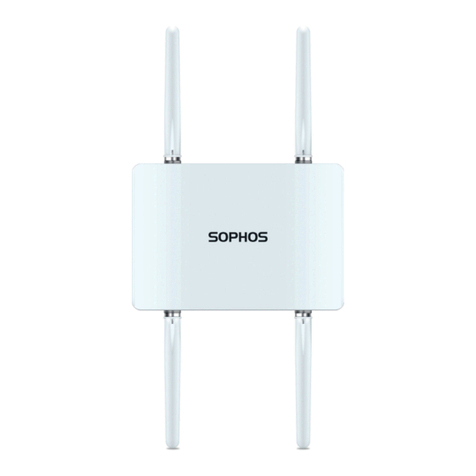
Sophos
Sophos APX Series Safety Instructions and Regulatory Information
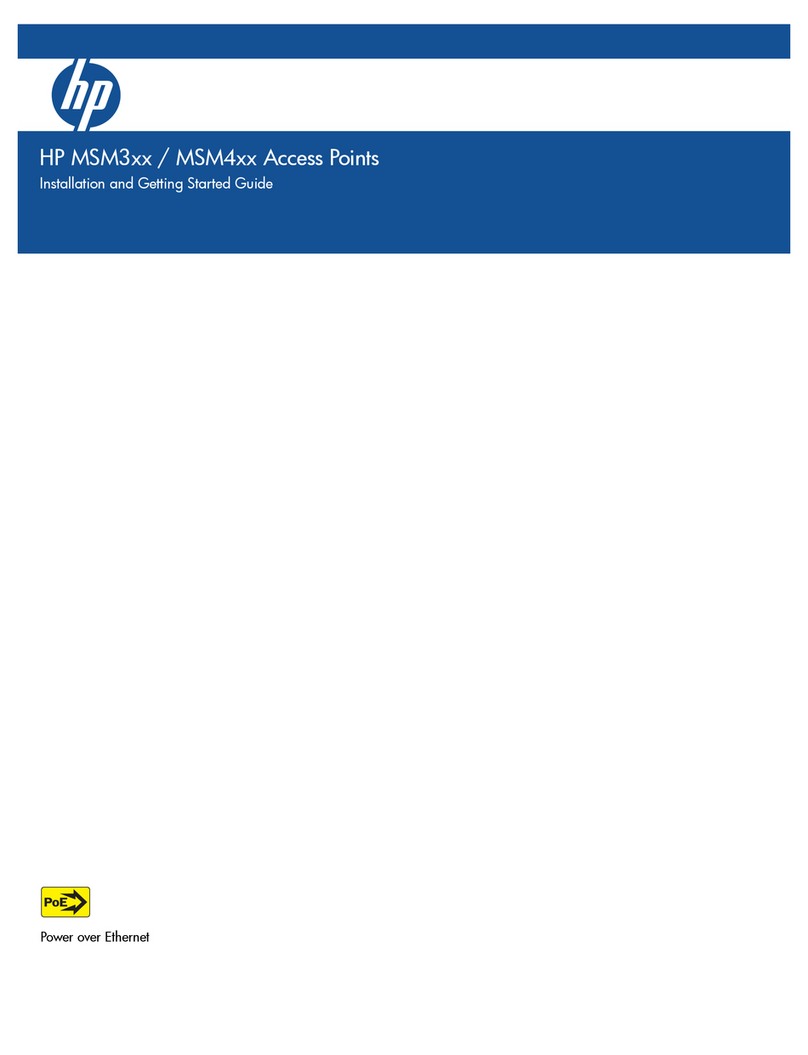
HP
HP msm4 series Installation and getting started guide
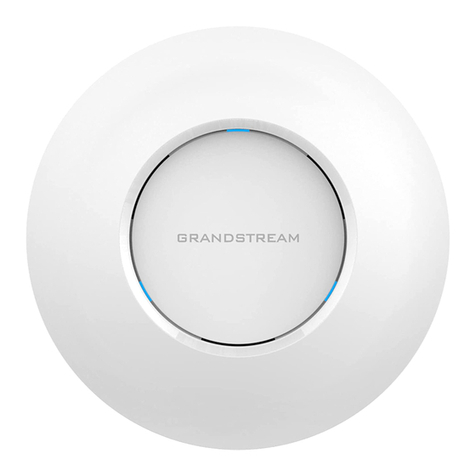
Grandstream Networks
Grandstream Networks GWN7615 Quick installation guide
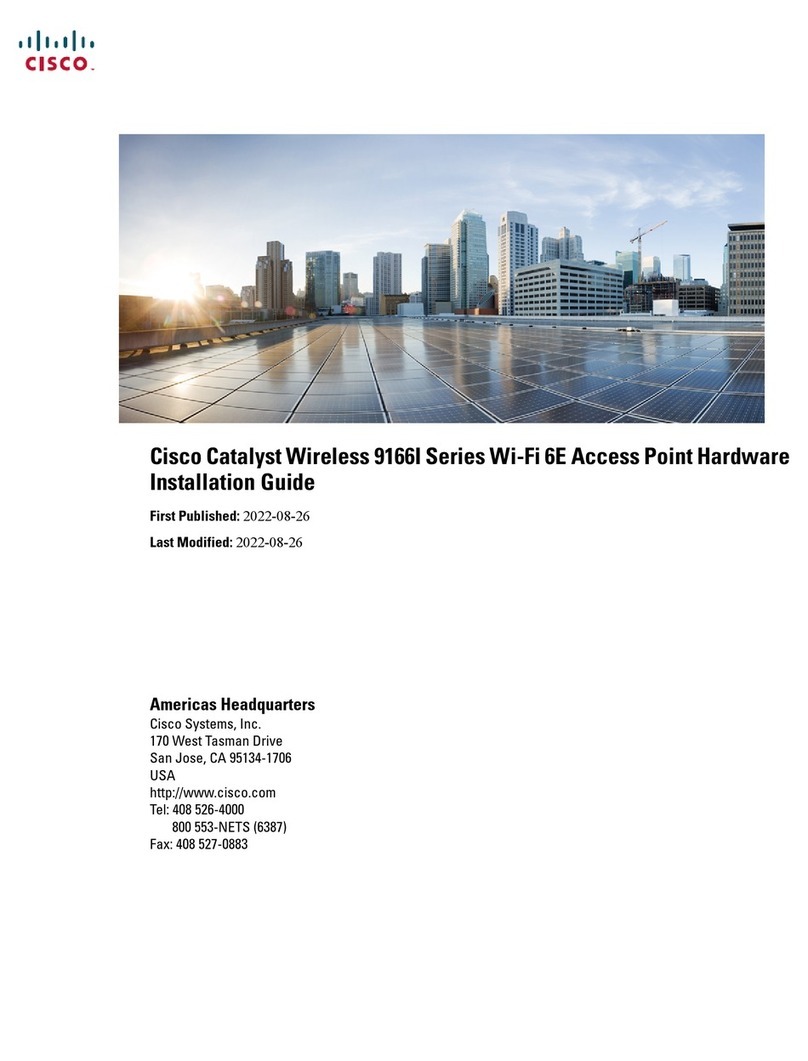
Cisco
Cisco Catalyst 9166I Series installation guide

NETGEAR
NETGEAR ProSafe Premium WNDAP620 Reference manual
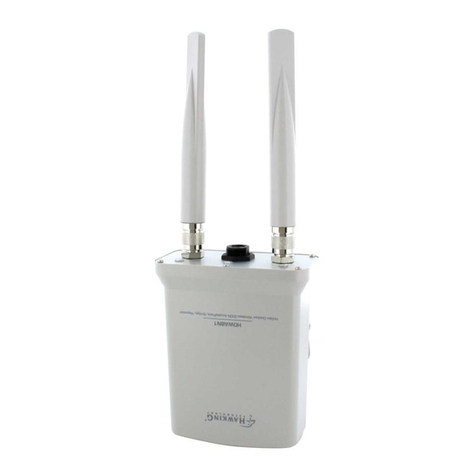
Hawking
Hawking HOWABN1 Quick installation guide
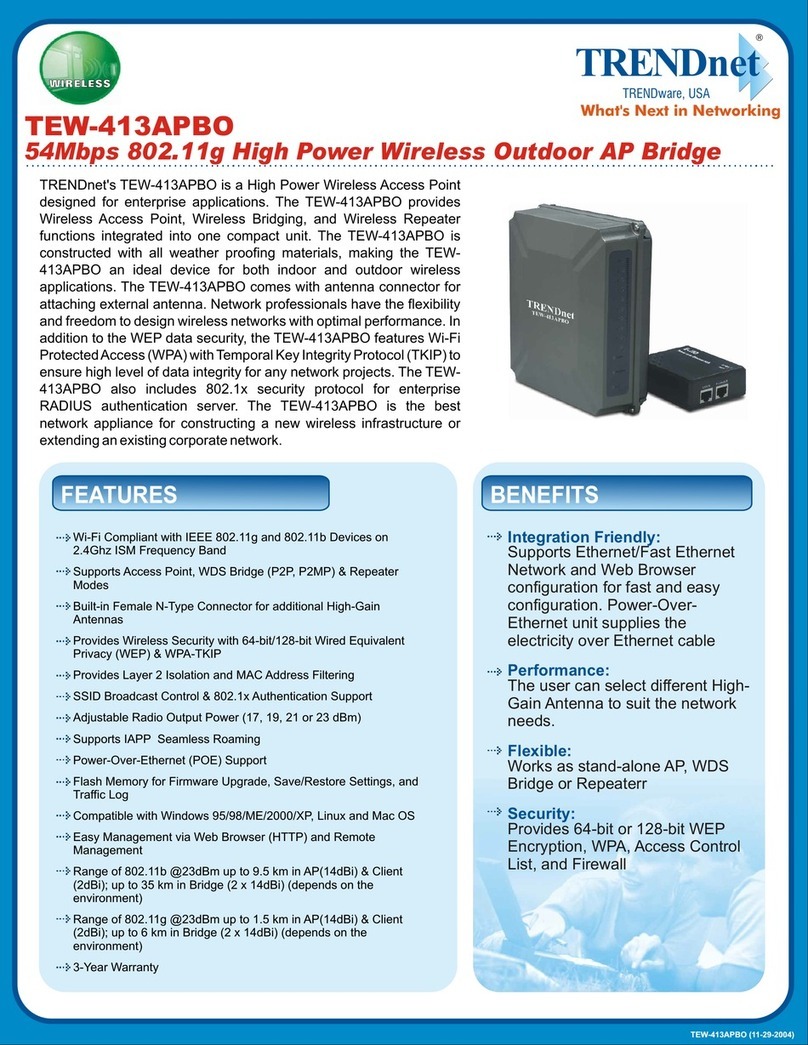
TRENDnet
TRENDnet TEW-413APBO Specifications
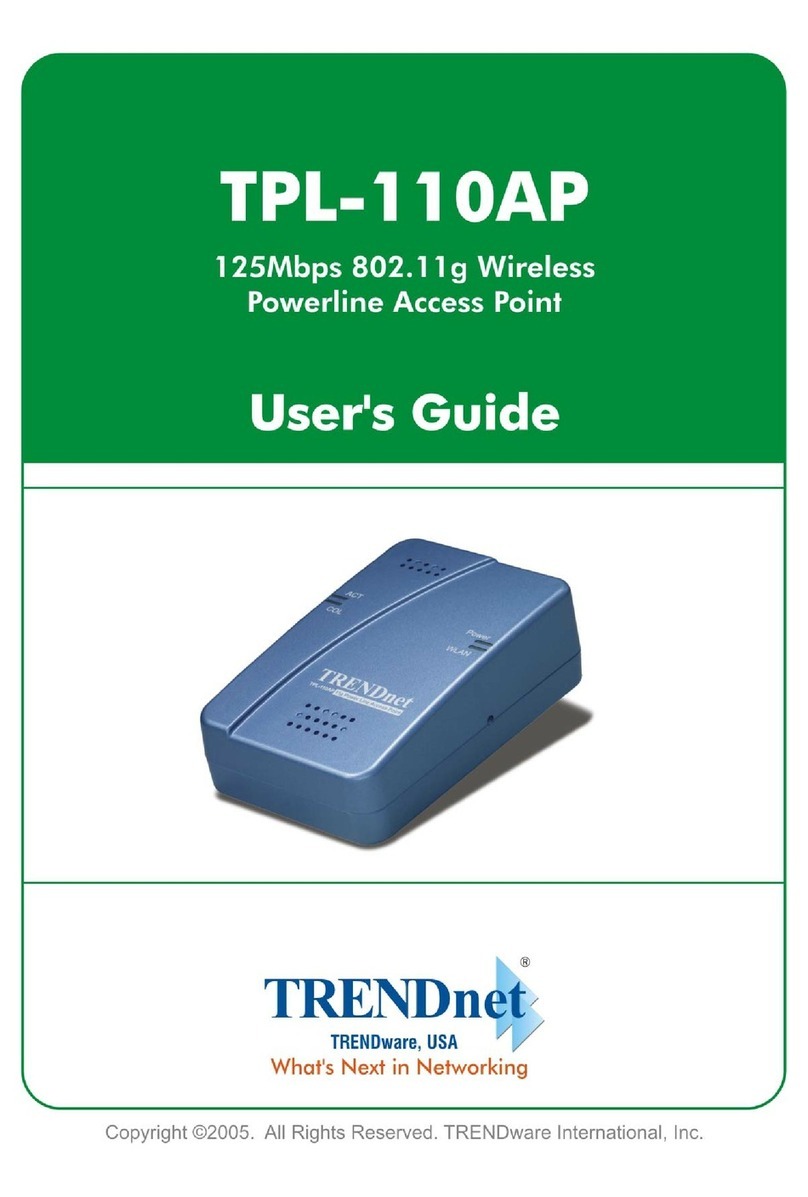
TRENDnet
TRENDnet TPL-110AP - 125Mbps 802.11g Wireless Powerline Access... user guide

iBall Baton
iBall Baton iB-WAP150N user manual
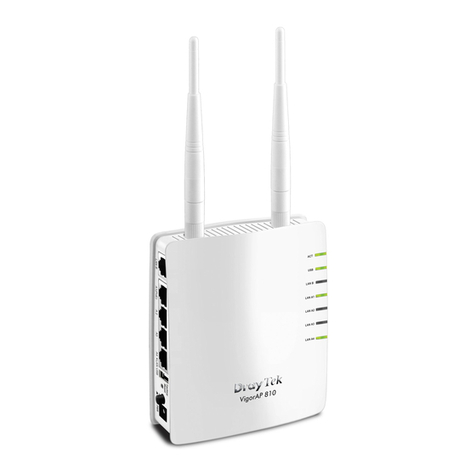
Draytek
Draytek VigorAP 810 quick start guide
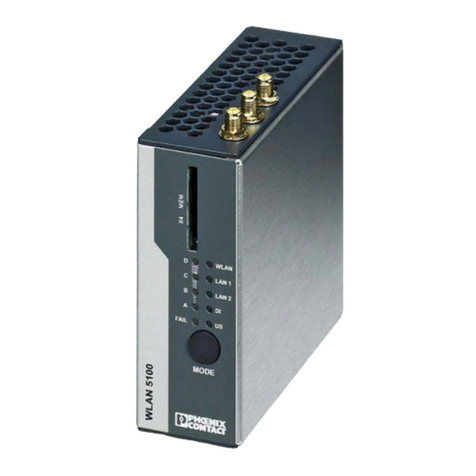
Phoenix Contact
Phoenix Contact UM EN FL WLAN 5100 user manual
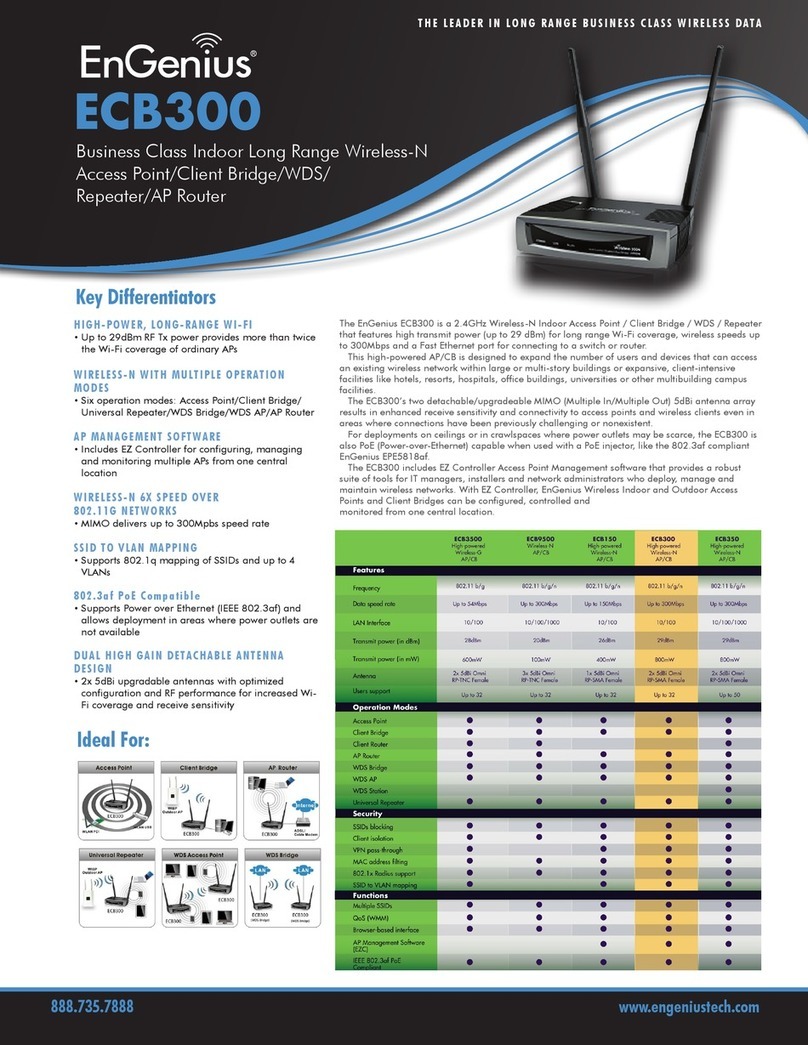
EnGenius
EnGenius ECB300 Technical specifications
